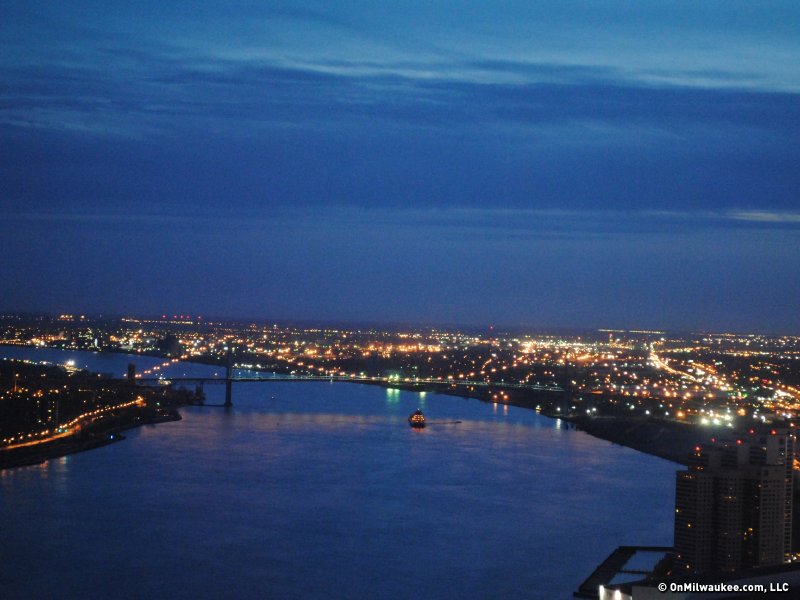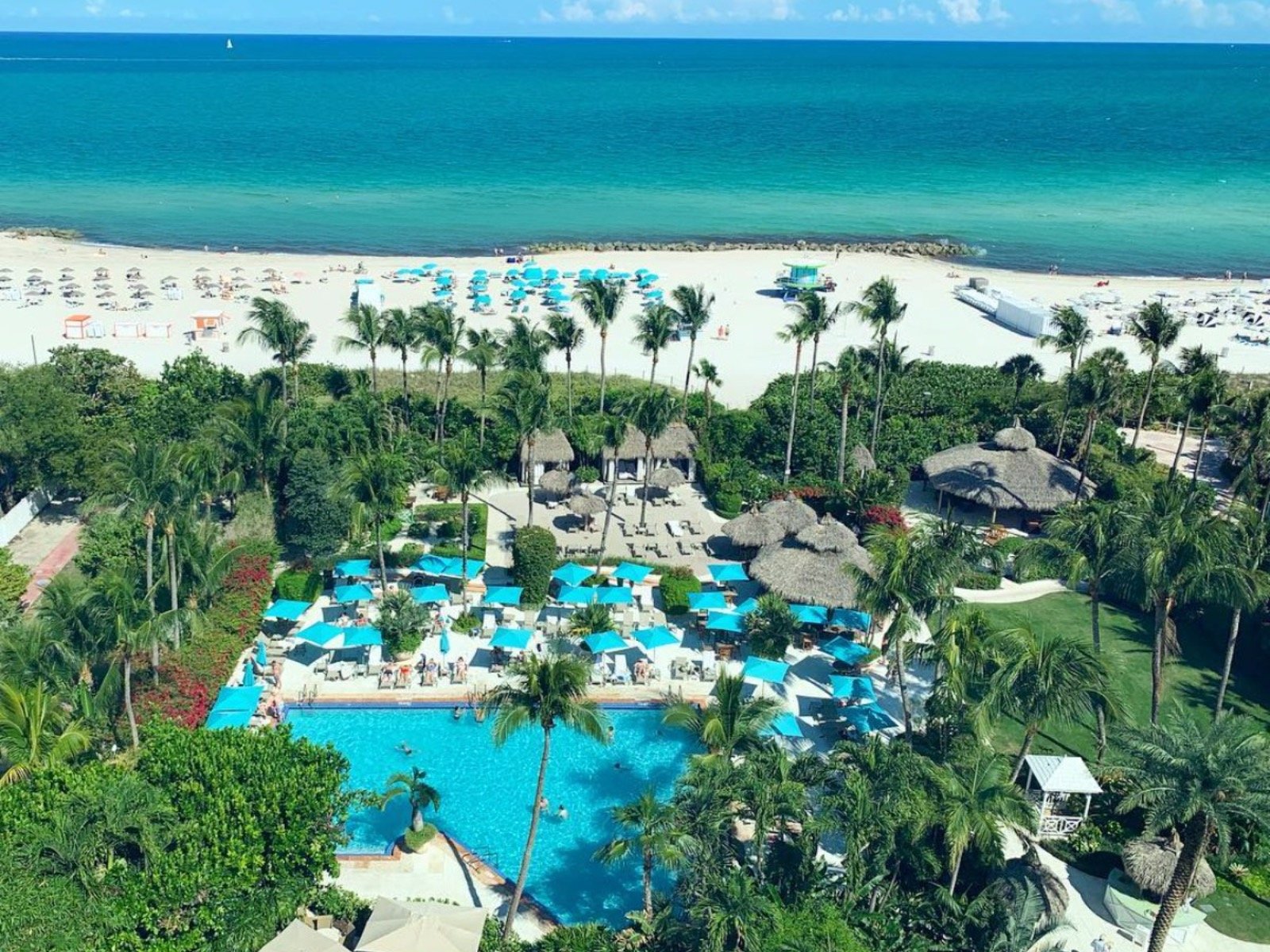DETROIT – In years past, stunning-yet-depressing photo collections of a very decaying Detroit appeared in magazines and circulated on the Internet. The photos depict a ghost-towny ghetto suffocating under rubble and spray paint with more junked cars than new ones.
And although the devastation might be media hyped, it's not a lie. Detroit – a city that lost 25 percent of its population from 2000 to 2010 – is in deep financial trouble, has a high crime rate and a disproportionate number of abandoned, burned-out buildings.
The struggling Motor City – which, these days, is about as accurate as Milwaukee's "Brew City" moniker – is no longer the hub of the American Dream but it conveys a new state, one that requires creativity and resiliency to survive.
In the past few years, Detroit has started to come around again and many new businesses, mostly bars and restaurants, are opening all over the city. The addition of three casinos has helped the city attract more visitors.
Both gritty and pretty, Detroit can be, for the right travelers, a fascinating, fun-filled vacation destination. It's a six-hour drive from Milwaukee, but an easy one, especially when traveling 294 which bypasses Chicago.
Milwaukee's Elaine Litzau visited a few years ago. "It seems to be dripping with opportunity despite all of the other major problems. Like a palette of dried up paints that, if you just add the right solvent, you could bring those colors back and have a fresh start at a new painting," she says.
During our recent five-day stay, we expected to sift through the rubble to find the gems, but as it turns out, many were right in front of us, sticking out like hood ornaments.
D-town eats: From quintessential Coneys to new-school veggie
In Detroit, soda is called "pop" (it's home to Faygo and the only place on the planet where the rock 'n' rye cream soda flavor is easily available) and the chili dogs are often called "Coney Islands."
The Coney Dog was invented in Michigan, not New York, and isn't the same as a chili dog, mostly because of its use of beanless chili. There are hundreds of restaurants, mostly Greek-owned, featuring the word "Coney." The most famous, Lafayette Coney Island and American Coney Island, are located Downtown.
The two diners are owned by rival brothers and many locals have an allegiance to one restaurant or the other, even though they feature very similar food: beanless-chili dogs with raw chopped onions and mustard, a loose hamburger meat called "loosey," bowls of chili with or without meat and French fries. Lafayette also has a thick bean soup.
We ate at Lafayette where orders are conveyed from server to cook through shouting and meals are presented within two minutes. We chowed down on a couple of Coneys and followed them with Labatt's (the close proximity of Canada makes this a commonly available brew). The chili sauce on the dogs isn't spicy, but definitely thick and flavorful. Supposedly, the casings on Coney dogs are unique, but we didn't taste this.
The decor at the two restaurants is very different. Lafayette, originally opened in 1917, is a classic diner with seemingly few to no renovations in recent years. American is much larger (it expanded in 1999), has a newer, "shinier" feel and is aptly adorned in red, white and blue.
Slow's Bar-B-Q, located inside a restored building from the late 1800s in the hip Corktown neighborhood, is much newer to the scene – it opened in 2005 – but has quickly become a dining staple in Detroit. Recently, a second location, Slow's-To-Go, opened in Midtown.
The Wall Street Journal rated Slow's as one of the United States' top 10 barbecues. It's also condiment heaven. Every meal is served with five bottles of signature sauce including sweet apple, spicy mustard and North Carolina vinegar.
Popular sandwiches include The Longhorn, which is a beef brisket slathered with onion marmalade, smoked gouda and spicy sauce. The Triple Threat, a pulled-pork sandwich topped with Applewood bacon, is another favorite and there's a tasty veggie sandwich, The Genius, that's made with vegetarian "chicken" and topped with homemade cole slaw.
Slow's is also a great place to drink, offering more than 100 beers, with 20 or so on tap. It was also the place where we enjoyed our first Ghettoblaster beer, a mild ale made by the Motor City Brewing Works that quickly became a favorite. The Bloody Mary is great, too; made with extra horseradish it comes with a whole dill pickle (no chaser, though).
Like so many people we met in Detroit, Slow's bartender Gregg Alan Smith was easy to chat with. He tipped us off to other Corktown places to check out, including the brand new Mercury Burger Bar across the street and Astro Cafe next door.
"Astro is now the hipster Jerusalem of Detroit," says Smith.
The space is small, and the wait can be very long. Hence, during warm weather, people often grab it to go and eat somewhere in the Eastern Market, where many of Supino's ingredients are purchased. The Eastern Market is a six-block radius public market that's open every Tuesday and Saturday all summer and has been around since 1891.
Seva is another very new restaurant that features fresh, imaginative vegetarian, vegan and gluten-free food. The Detroit location celebrated its grand opening in January, and the original eatery is in Ann Arbor.
The General Tso's cauliflower appetizer is extraordinary. It's so similar in texture and taste to sweet-and-sour chicken that it's hard to believe it's vegetable based. The sauce is the perfect mix of opposing flavors and is caramelized on the soft cauliflower creating a thin, crispy coating. This could be ordered as a meal.
The bahn mi, a hoisin-glazed seitan with jalapenos, mung sprouts, shredded carrots and vegan aioli, is served on a French baguette and the banana curry featuring black rice is topped with a flavorful, chunky curry stew.
Seva has a great wine list and on Tuesdays glasses and bottles are half off. We got a nice bottle of French wine for $10. The place has interesting-sounding handcrafted cocktails, including the "green itch" made with gin, cucumber juice and basil syrup.
Other spots to consider are the Hudson Cafe for a good breakfast or lunch (if you have a sweet tooth, try the cream-cheese topped red velvet pancakes), Avalon International Breads (strong coffee, delicious homemade breads), Greektown's Pegasus for the saganaki and the Grand Trunk Pub for a Wisconsinite-approved fish fry battered in Ghettoblaster beer.
Detroit is for lovers ... and drinkers
Operating under the guidelines of "we're on vacation" and "it's always 5 p.m. somewhere," we stopped in a lot of bars during our Motor City vacation. Like restaurants, there are many new bars opening and even more that are scheduled to open in the coming year. Here are a few spots we liked the most.
Named after the patron saint of whiskey, St. Cece's is located in Corktown, across the street from a well-stocked record shop called Hello Records, and inside a former church building. The interior is a homage to the former religious space, with large, churchy, stained glass windows, dark wood and a massive stone fireplace.
The customers and staff were friendly and quick to make Detroit destination suggestions. We drank Motor City beers and bought locally-made jerky. One patron offered to hypnotize us in the basement and let us touch a massive black crystal he carries around in his brief case, but that's another story.
The Majestic is an entertainment complex in the Midtown neighborhood featuring a restaurant, two live music venues, four bars and a 16-lane bowling alley called the Garden Bowl.
When the Majestic Theatre opened in 1915, it was the largest theater in the world. The Majestic seats 1,000 people and, along with the Magic Stick which is adjoined, offers up live music most nights of the week.
For live jazz, Cliff Bell's is considered by many, including the New York Times, to be the best jazz club in Detroit. The famous club closed in 1985 and reopened in 2005.
Next door to Cliff's is the Park Bar, a Downtown Detroit gem that could easily be in New York or San Francisco. Park Bar opened earlier this year and is an open, modern space with huge windows, a round bar and large art pieces on the walls.
It features mostly Michigan-brewed beers from Atwater Rock Brewery, Motor City, New Holland, Shorts, Dark Horse and Founders, along with High Life (called "good ol' yellow beer" on the beer list) and Leinekugel's Summer Shandy. Plus, Park Bar is attached to the Bucharest Grill so food can be brought over at any time.
Cliff's, Park Bar and Bucharest are thriving businesses, and yet, like so many establishments in Detroit, they sit in the shadow of a towering abandoned building.
Sparkly gloves and wiener mobiles: museums not to be missed
Detroit music history is even more storied than its car history. Eminem, Kid Rock, Madonna, Bob Seeger, Alice Cooper, The Romantics, Marshall Crenshaw, Insane Clown Posse and The White Stripes are all from the area. But Detroit is most famous, of course, for its great R&B artists like Diana Ross, Aretha Franklin, Stevie Wonder and Marvin Gaye.
The Motown Museum offers tours for $10. The tour, which lasts about an hour, features a video about the history of Motown, the chance to see famous Motown-reated memorabilia – as well as one of Michael Jackson's sparkly gloves – and the chance to hang out in the famous Studio A where Motown greats such as Martha Reeves and the Vandellas, Marvin Gaye, Stevie Wonder, Smokey Robinson and the Miracles, the Temptations, the Four Tops, Gladys Knight and the Pips, Diana Ross and the Supremes and the Jackson 5, among others, recorded their hits.
Studio A's current piano is a stand-in for the original. Apparently, Paul McCartney visited the museum in summer 2011 and was disappointed to find out that he couldn't play the Steinway because it was in such rough shape, so he had the grand piano shipped to New York to get restored. The cost was more than $25,000 and McCartney will supposedly return to play the piano once it comes back home.
The Henry Ford Museum was a pleasant surprise for us. Expecting to see Model T's and a bunch of other Detroit-made autos, we were thrilled to get up close and personal with the original wiener mobile, what's believed to be the oldest remaining school bus, an original Volkswagen camper, the bus on which Rosa Parks refused to sit in the back, the chair Abraham Lincoln was assassinated in and more.
There are plenty of autos on display, too, as well as a hilarious (and scary) section on the evolution of the child's car seat, which, according to museum information, "weren't always about safety ... (they were) more about parents' convenience."
The Detroit Institute of Arts is a bargain with an $8 admission and well worth a stop, especially to see the incredible pro-labor murals by Diego Rivera. The murals, called "Detroit Industry," consist of 27 panels created from April 1932 to March 1933.
Rivera, a Marxist, believed that art belonged on public walls rather than in private galleries. "Detroit Industry" is considered the finest example of Mexican mural art in the United States, and Rivera believed it was the best work of his career.
Urban nature
Although it's known as Motor City, these days there's a lot of focus on making the city a bike-friendly destination. There are many bike trails that range from the off-the-beaten path to the more urban, including the Dequindre Cut on Detroit's East Side featuring lots of colorful graffiti.
Wheelhouse Detroit, a bike shop with rentals located along the Riverfront, has over 90 planned bicycle tours of Detroit with different themes, destinations and special packages. For example, choose the five-mile Eastern Market tour in April for $25 ($35 with bike rental) and get lunch with a walking tour of the market, too. Other bike trips include a tour of Belle Isle, a public art tour, an underground railroad tour (Detroit was a major stop for escaped slaves on their way to freedom) and an auto heritage ride, which takes bikers through several old car industry sites.
Detroit is improving numerous aspects of its natural world. The Detroit Riverfront Conservancy, formed in 2003, works to develop access on the aforementioned Detroit International Riverfront, which is 5 1/2 miles along the Detroit River. The city, the state, private companies and foundations contributed several hundred million dollars toward the riverfront development that now serves as a venue for many events, including the American International Auto Show and River Days.
Windsor, Canada is on the other side of the river and accessible via the Ambassador Bridge or the Detroit-Windsor underwater tunnel. United States citizens need passports to visit Canada. We spent an evening in Windsor, where we found a lot of Tim Horton's coffee shops and strip clubs and enjoyed the concept of being outside the U.S., if only for a few hours. It was fun to use Canadian money, note different spellings ("mould" and "centre" for example) and people watch.
For six years, D-Town Farm, operated by the Detroit Black Community Food Security Network, has cultivated more than two acres in Rouge Park. It has served as the Detroit-area Regional Outreach Training Center for Milwaukee's Growing Power, Inc. and provides food and a healing environment to citizens. In November, the Detroit City Council approved a five-acre expansion. We visited the project and found it very productive and serene.
Heidelberg = hardcore lemons-into-lemonade action
The Heidelberg Project was the most fascinating and inspiring aspect of the trip. It began in 1986, when Tyree Guyton and his grandfather first started to transform abandoned houses into art pieces. The neighborhood, which once featured 66 houses, now has six.
All of the remaining structures – as well as the open lots surrounding them – have been transformed into a folk art / political statement / outdoor museum.
The neighborhood, which includes Heidelberg Street, was once a place that people were afraid to walk through during the day. Today, it attracts thousands of visitors and celebrities every year.
"In one of the poorest communities in the country, because of the art, it's now the third most visited cultural site in Detroit," says Sharon Luckerman of the Heidelberg Project. "In the 26 years this has been here, there has not been one serious crime."
One of the houses is covered entirely in polka dots painted by Guyton, his father, neighbors and visitors to the sight. Guyton's mother lives in this house.
Another house is covered in painted numbers and clocks and the Party Animal house is adorned with hundreds of stuffed animals. (Although the house is playful looking, it is also a dark statement that "party animals" once lived inside).
The installations between the houses are as amazing as the houses themselves. There's a Hummer, painted pink and submerged into the ground with a tree growing out the top of it and a bicycle springing out in front of it, along with painted old televisions and telephones, shopping carts in the very tops of trees, piles of painted shoes, portraits painted on old car hoods (Guyton calls these "faces in the hood") and large cut-outs of the same man holding signs which say things such as "Give me power" and "Detroit Police: stop killing kids."
Most of the mayors of Detroit have not been supportive of the effort and, over the years, a few of the houses were demolished by the city. But Guyton doesn't give up. He and his staff continue to grow and now reach beyond the neighborhood, teaching art in schools, many without any other access to art education.
Luckerman, who has lived all over the country including Chicago and Portland, made Detroit her permanent home 30 years ago. For her, The Heidelberg Project serves as both reality and metaphor for what's happening in Detroit.
"You see the rawness here of wonderful human endeavors that are making this city work again," she says.
Molly Snyder started writing and publishing her work at the age 10, when her community newspaper printed her poem, "The Unicorn.” Since then, she's expanded beyond the subject of mythical creatures and written in many different mediums but, nearest and dearest to her heart, thousands of articles for OnMilwaukee.
Molly is a regular contributor to FOX6 News and numerous radio stations as well as the co-host of "Dandelions: A Podcast For Women.” She's received five Milwaukee Press Club Awards, served as the Pfister Narrator and is the Wisconsin State Fair’s Celebrity Cream Puff Eating Champion of 2019.







